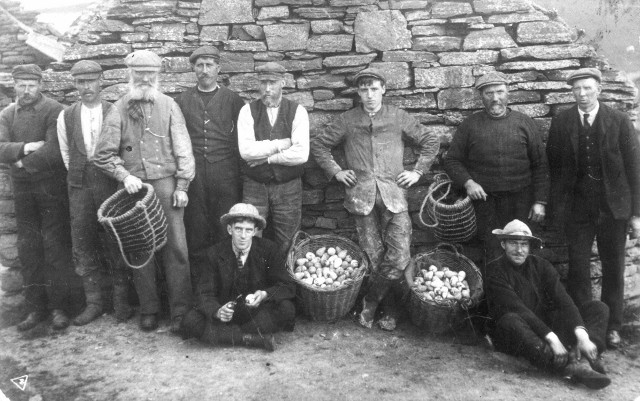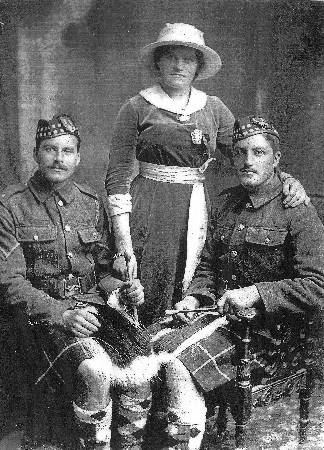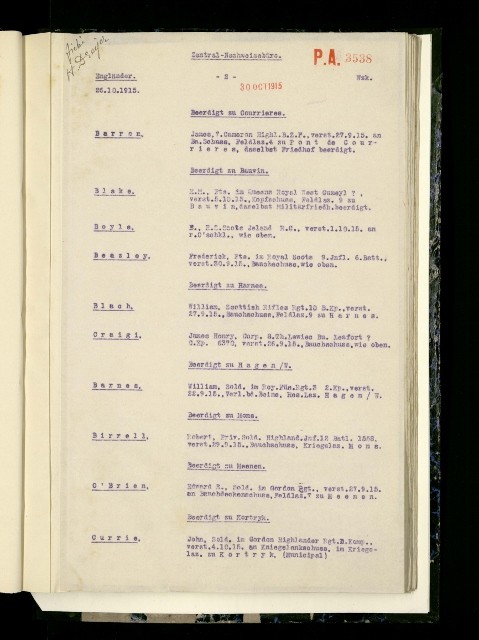James H. Craigie
James Henry Craigie was born on 23rd June 1891, the eldest son of William and Margaret Craigie, nee Foubister, of Breck, Deerness, Orkney. William and Margaret were married at Mussaquoy, Deerness on 10th April 1890 when he was 24, she 16. William’s parents were David Craigie and Ann, nee Stove of Barebreck, Deerness and Margaret’s parents were James Craigie of Holm and Robina nee Foubister of Mussaquoy, Deerness. William and Margaret had another 2 children - William born on 6th August 1894 and Alice born 31st January 1896.
James started school in Deerness on 1st June 1897, leaving in May 1905, a month less than 14 years old. In the 1911 Census he is recorded as working at Breck with his father, brother William and his sister, Alice. Breck was a 60 acre farm and Pa o’ Breck, as their father was called, needed his family’s help to run the farm. The two-storey house at Breck looked much as it is today, with its views of Copinsay and the Bay of Newark, and south.
In 1910, James took part in the Deerness Ploughing match at Kitchen o’ Brecks and Yarpha, coming 12th for his ploughing, and 5th for his horse-grooming at. In 1911, he was 5th for his horse-grooming at the match at Braebuster, Deerness and in 1912, 6th for ploughing in the match at Greenhall, Yarpha and South Keigar, Deerness. His address is given as Aikerskaill for both 1911 and 1912, so it appears he was working there then, rather than wholly at home at Breck. He also competed in turnip hoeing matches at Barns o’ Ayre in 1911, coming in, in 5th place and 11th at Millfield in 1914.
The photo below, courtesy of Orkney Archive, was taken on the island of Copinsay, off Deerness, showing a group of Deerness men with baskets of eggs, collected from the cliffs of Copinsay, by men ‘’running the lea’’, roped down over the edge of the cliff to collect seabird eggs. The young man sitting at the front right is James Craigie. It’s difficult to know if he’s been over the cliff, or was he a helper at the top? His hands are dirty but his dark clothes clean by comparison to the white-stained clothing of young William Foubister, standing behind James, to his left.
When he was 17, on 3 June 1908, James joined No 6 Company of the Orkney Royal Garrison Artillery, the Territorial Army, at the Free School, Deerness and attended summer camps in Kirkwall. James’s enrolment records show he was 5’6’’tall, chest expansion 35’’ to 37.5’’, vision good and physical development good. His service no was 299. He was discharged on 2 June 1912, having completed his standard 4 years of service.
In September 1914, James, his brother William and their friend Tom Foubister of Little Grindigar, Deerness enlisted with the 8th (Service) Battalion, Seaforth Highlanders, 44th Brigade 15th (Scottish) Division in Kirkwall. James’s number was S/6370. The Battalion was formed at Fort George near Inverness in September 1914 and went then to Aldershot, to Petersfield in November 1914, then Chisledon Camp on Salisbury Plain in February 1915, Tidworth in May 1915 and on 4 July 1915 the Battalion received their orders for France, arriving in Boulogne on 8th July. Prior to that, in June 1915, the Craigie brothers and Tom Foubister were given embarkation leave, home to Deerness and the photo below is of James and William, with their sister Alice, taken in June 1915. Photographs of the three appeared in Our Roll of Honour section of The Orcadian newspaper that summer.
A poem, Neuve Chapelle, appeared in The Orcadian in August 1915 attributed to Lance Corporal J H Craigie. The verses are not originally from his pen and appeared widely at the time in the Scottish counties from which the Seaforth Highlanders were recruited but adapted to suit each location. Jimmy Craigie may have made the Orkney adaptation and brought it home. What did his parents think, reading it, with 2 sons and Tommy Foubister heading to France?
On 6th August 1915, the Battalion took over a sector of the line from the 7th Cameron Highlanders with the transfer of men into the trenches accomplished by 11pm that night. On 9th August, William Craigie was the Battalion’s first casualty, when he was slightly wounded on his scalp and nose by shrapnel. Between early August and 20 September the Battalion spent time, occasionally under fire, in the trenches working to make them better fit for purpose and out again in billets where they also worked to make themselves battle-ready.
On 21 September 1915 they were in trenches at Grenay Vermelles and artillery bombardment of the enemy began. On 24 September, they moved into front-line trenches and at 6.30am on 25 September the men, having been previously fed and had an issue of rum, started the attack in splendid spirits and so began the Battle of Loos.
Prior to coming over the top, and the launch of their attack, the British had unleashed gas for the first time, the Germans having previously employed its hideous effect. For 40 minutes prior to 6.30am, alternate releases of gas and smoke were made but there was little wind to move the dreadful mixture into the German trenches and some of the Seaforths were themselves unable to attack, having been gassed by their own side. The Germans moved quickly back to Loos itself, emptying their trenches for the British to take but with many losses. Hard hand to hand fighting then took place and the village was cleared and the Seaforths and other regiments of the Brigade advanced onto Hill 70 beyond Loos, in error. The attack should have been against Cite St Auguste but confusion over maps and landmarks led to the move onto Hill 70 which was disastrous. The Hill proved impossible to hold and eventually it was abandoned on 30 September, and eventually re-captured only in August 1917.
Records show that on 25 September 1915, 8 officers and 250 other ranks of the 8th Battalion were killed in action and 2 other ranks died of wounds. On 26 September 1 officer and 7 other ranks were killed in action, and 1 officer and 8 other ranks died of wounds; a further 3 other ranks died of wounds on 27 September, 2 on the 28th and 1 officer on the 29th. A further 1 officer and 13 other ranks died of wounds between 1 and 31 October. The Battalion therefore lost 285 other ranks, including Jimmy Craigie and Tommy Foubister, and 11 officers killed at Loos plus many more wounded or gassed (including James’s brother, William). At absolute full strength a battalion was made up of 1007 men and officers. At Loos the 8th Battalion Seaforth Highlanders saw more than 1 in 4 of its number killed over a 30 hour period on 25 and 26 September.
James Craigie died, a prisoner of war, of stomach wounds on 26 September 1915 in a German field hospital in Harnes, 20 kilometres from Loos. The International Red Cross was notified of his death and burial at Harnes on 30 October 1915.
He was buried there by the Germans and lay there until post 1918 when he was laid to rest in Lievin Communal Cemetery Extension, now under the care of the Commonwealth War Graves Commission. He is buried in plot 1, row F, grave 8.
His friend Tommy Foubister died on Monday 27 September 1915, and is buried at Mazingarbe, approximately 6 miles from Lievin.
In the 18 December 1915 edition of The Orcadian the following report appeared
‘The parents of Lance Corporal J H Craigie (a native of Deerness) of the 8th Battalion Seaforth Highlanders have been notified that their son was killed in action at Loos in September. Lance Corporal Craigie was first reported missing and it was stated at the time that he was neither killed nor wounded, and the presumption was that he had been taken prisoner. No news came from him however, and a few days ago the relatives were officially notified that he had been killed. Lance Corporal Craigie is the third of four young Deerness men who has fallen. The fourth, his brother, has been twice wounded and is still in France. The relatives have the sincerest sympathy of the whole community in their bereavement.’
William was killed 11 months later, on 26 August 1916, during the Battle of the Somme. He was never found and is remembered on The Panel of the Missing at the huge Thiepval memorial to the lost of the Somme. In September 2004, a new visitor centre was opened at Thiepval and William is commemorated there, along with the tragic fact that his brother James had also been killed, the year before.
James and William’s sister, Alice, married James Lennie Brass of Ducrow in Holm in 1927. Their son, William Craigie Brass married Isobel Rosie of Grind, Deerness and they had two children, Norman William Brass and Johanna, now Geddes. Norman’s son is William Craigie Brass, Johanna’s son Graham James Geddes. Both Norman and family and Johanna and family have visited Lievin Cemetery and Thiepval and keep their grand uncles’ medals and bronze memorial plaques. Johanna also purchased one of the memorial red china poppies from the Tower of London, in 2015, and it is currently held by the Friends of St Ninian’s as part of the ongoing commemoration of Deerness’s World War 1 dead and survivors.
Deerness is a small community, with a population of c. 650 during World War 1. There are 13 men listed on the War Memorial, all from World War 1, including the two Craigie boys, David Linklater, James Cromarty, John L Mowat and Tom Foubister. The Craigie boys were first cousins to David Linklater, whose mother Ann was their father’s sister. They were first cousins to James Cromarty, whose mother Euphemia was also their father’s sister. Their grandmother, Robina Foubister/Craigie/Mowat was stepmother to John L Mowat. Their grandmother, Robina, was also a first cousin of Robert Foubister, father of Tom, with whom the Craigie boys signed up for what probably seemed like a very big adventure.






